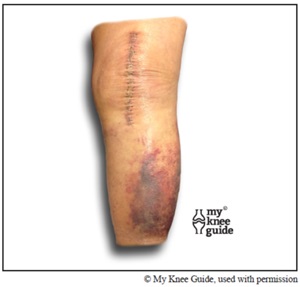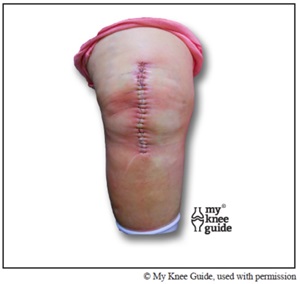
What your incision should look like after total knee replacement
Incision healing after surgery
Taking care of your incision is important to prevent infection and scarring, and to help your knee heal properly after surgery.
You should look at your incision every day and keep it clean while it heals (unless you are wearing a dressing that your surgeon will remove at your follow-up appointment). Follow any instructions your surgeon gives you for caring for your incision.
Call your surgeon if you have any questions or concerns about how your incision is healing.
Please read your discharge instructions for more information about incision care.

Your leg will have swelling and bruising after surgery.

Redness along your incision is also common.
Common symptoms after surgery
Your incision will be swollen, bruised (black and blue in color) and may be red after surgery. These symptoms are common and part of the healing process. (See photo at left.)
The following symptoms are also common after surgery:
- temperature below 101.6 F
- discomfort, fatigue or pain
- warmth or numbness around your incision
- spotty drainage, red or clear in color, lasting for one to five days
It is important to monitor your symptoms every day to make sure your incision is healing properly.
Your incision two weeks after surgery
Your incision will still be sore after two weeks but you should be able to see a decrease in swelling, bruising and redness. It is important that you continue to keep your incision clean and dry as it heals.
Your incision six weeks after surgery
You should feel an improvement in the amount of pain you have after six weeks. Continue to monitor the appearance of your incision and your symptoms as you begin to return to your normal activities.
When to call your surgeon
Call your surgeon if you have:
- a temperature of 101.6 F or higher
- a sudden increase in drainage, draining lasting more than five days after your surgery, or drainage that is yellow in color or foul-smelling
- severe discomfort, fatigue or pain
- severe swelling that does not improve each day
- blisters around your incision
- any change in movement such as new weakness, firmness in your calf muscle or inability to move as usual
- any questions or concerns
Related resources